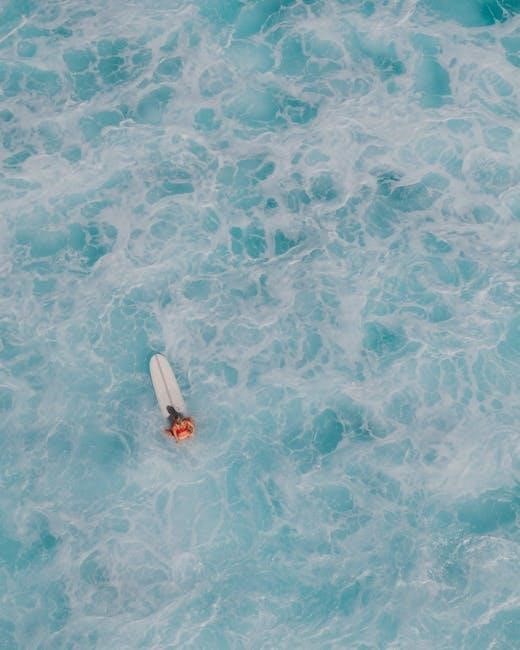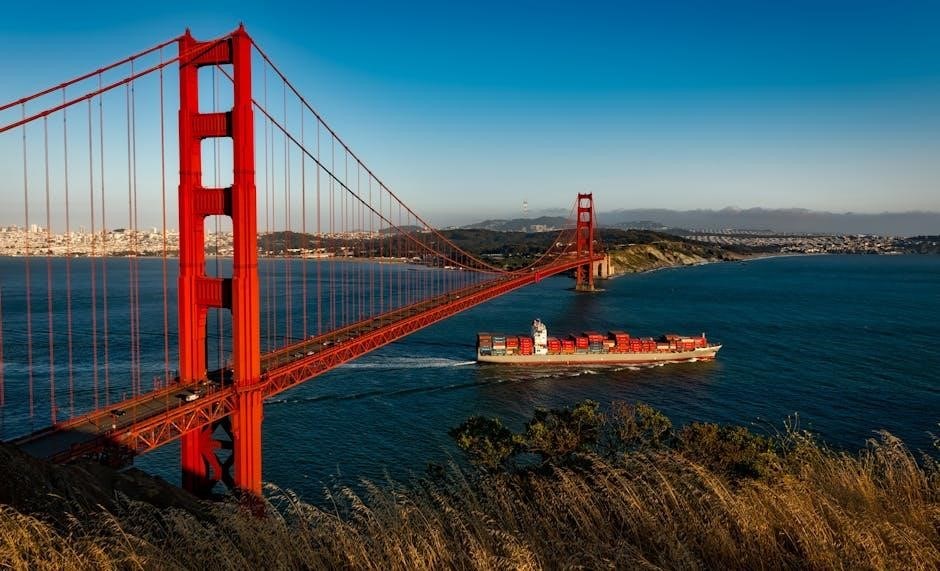
Red Sea Regulations and Guidelines
The Red Sea’s allure as a tourist destination necessitates clear regulations. These guidelines, often available as PDFs, cover safety, environmental protection, and navigational protocols. Staying informed about these rules ensures responsible and secure operations within this vital maritime region.
Overview of Red Sea Regulations
The Red Sea regulations encompass a broad spectrum of maritime activities. Primarily, these rules address vessel registration, safety certification, and crew qualifications. Environmental protection is another core area, focusing on minimizing plastic waste, preventing pollution, and preserving marine life. Diving regulations, navigational safety, and security measures, including anti-piracy protocols, are also integral components. Oil discharge restrictions, particularly within special areas, are strictly enforced. The Saudi Red Sea Authority (SRSA) plays a crucial role in licensing and permitting processes to ensure compliance with these comprehensive regulations.

Safety Regulations for Vessels
Vessel safety in the Red Sea is paramount. Regulations mandate valid safety certificates, qualified crew, and adherence to operational standards. These measures aim to protect lives, cargo, and the marine environment from potential hazards and accidents.
Registration and Certification Requirements
All vessels operating in the Red Sea must be properly registered with the Saudi Red Sea Authority (SRSA) or other relevant maritime administrations. This registration process ensures accountability and compliance with international maritime laws. Furthermore, vessels must possess valid safety certificates, demonstrating adherence to safety standards, equipment maintenance, and operational readiness. These certifications are crucial for safe navigation and emergency preparedness, promoting responsible maritime activities within the Red Sea region.
Crew Qualification Standards
To ensure the safety of navigation and operations within the Red Sea, all crew members on board vessels must meet specific qualification standards. These standards typically include certifications for navigation, engineering, safety procedures, and medical assistance. Crew members must be adequately trained and possess the necessary skills to handle various situations, including emergencies and adverse weather conditions. Proper qualifications contribute to a safer maritime environment, minimizing the risk of accidents and ensuring the well-being of all personnel on board.

Environmental Protection Standards
Protecting the Red Sea’s unique ecosystem is paramount. Environmental standards include guidelines for waste reduction, pollution prevention, and marine life preservation. These measures aim to minimize the impact of maritime activities on this sensitive environment.
Guidelines for Reducing Plastic Waste
The Red Sea faces a significant threat from plastic waste, necessitating strict guidelines. These guidelines emphasize minimizing single-use plastics onboard vessels, promoting proper waste disposal methods at ports, and encouraging recycling initiatives. Educational programs for crew and passengers can raise awareness. Enforcement of these rules is crucial to protect marine life from entanglement and ingestion of plastics. Compliance with these measures is vital for preserving the Red Sea’s fragile ecosystem. These efforts help maintain the beauty and health of the Red Sea for future generations, safeguarding its biodiversity.
Pollution Prevention Measures
Stringent pollution prevention measures are essential for the Red Sea’s ecological health. These include regulations on waste discharge, sewage treatment, and air emissions from vessels. Regular inspections and monitoring ensure compliance with environmental standards. Contingency plans for oil spills and other accidents are crucial. Promoting the use of eco-friendly technologies and fuels can significantly reduce pollution. Collaboration between maritime authorities, shipping companies, and environmental organizations is vital for effective enforcement; Strict adherence to MARPOL conventions further strengthens pollution control. These measures collectively safeguard the Red Sea’s marine environment from harmful pollutants, ensuring its sustainability and biodiversity.
Preservation of Marine Life
Protecting the Red Sea’s diverse marine life requires dedicated preservation efforts. Regulations include establishing marine protected areas, restricting fishing activities, and safeguarding coral reefs. Monitoring programs assess the health of marine ecosystems. Preventing damage from tourism activities is crucial. Measures include responsible diving practices and controlling coastal development. Combating invasive species is vital for maintaining ecological balance. Research and conservation initiatives enhance understanding and protection of vulnerable species. Collaboration between governments, scientists, and local communities is essential. By implementing these strategies, we can ensure the long-term survival and health of the Red Sea’s unique marine biodiversity for future generations.

Diving Regulations and Safety
Diving regulations in the Red Sea prioritize safety and environmental protection. These rules, often detailed in PDF documents, govern dive operations, guide qualifications, and equipment standards. Compliance ensures a safe and sustainable diving experience for all participants and protects the fragile marine environment.
Regulations for Diving Guides and Instructors
Red Sea diving regulations place significant emphasis on the qualifications and responsibilities of diving guides and instructors. These individuals must possess valid certifications from recognized diving organizations, demonstrating proficiency in diving skills, safety protocols, and emergency procedures. Furthermore, guides and instructors are responsible for ensuring the safety and well-being of their dive groups, adhering to established dive plans, and educating divers about the local marine environment and conservation efforts. Strict adherence to these regulations, often outlined in accessible PDF documents, is crucial for maintaining the integrity and safety of diving operations in the Red Sea.
Safety Regulations for Dive Boats
Dive boat safety in the Red Sea is governed by stringent regulations detailed in comprehensive documents, sometimes available as PDFs; These regulations mandate regular inspections and certifications to ensure seaworthiness and compliance with safety standards. Essential safety equipment, including life jackets, first-aid kits, and communication devices, must be readily available and properly maintained. Additionally, dive boats must adhere to strict operational guidelines, including passenger limits, crew qualifications, and emergency response protocols. Compliance with these safety regulations is paramount for safeguarding passengers and crew and preventing accidents during diving excursions in the Red Sea.

Navigational Safety and Security
Ensuring safe passage through the Red Sea requires strict adherence to navigational protocols. Updated guidelines and security measures, potentially found in downloadable PDFs, are crucial. Voyage planning, reporting, and anti-piracy measures are key components.
Anti-Piracy Measures and Guidance
Given the geopolitical instability affecting Red Sea navigation, anti-piracy measures are paramount. Guidance, potentially accessible via PDF documents, focuses on deterring, delaying, detecting, and reporting attacks. Experience demonstrates that diligent application of these measures is vital for voyage security. Ships must plan routes carefully, remaining vigilant and implementing recommended security protocols. Collaboration and information sharing among vessels also bolsters collective security. Understanding current threats is essential.
Voyage Planning and Reporting Protocols
Effective voyage planning is crucial for safe navigation in the Red Sea. Protocols, often detailed in accessible PDF documents, necessitate comprehensive risk assessments. These assessments should consider geopolitical factors, weather patterns, and navigational hazards. Vessels must adhere to strict reporting protocols, providing updates on their position and any encountered incidents to relevant authorities. Clear communication channels must be established and maintained throughout the voyage. Proper planning and adherence to reporting requirements contribute significantly to maritime security. Ignoring these protocols can lead to incidents.
Oil Discharge Restrictions
Stringent regulations prohibit oil discharge in the Red Sea, a designated special area under MARPOL. These restrictions, often outlined in accessible PDFs, aim to protect the marine environment from pollution caused by oil and oily mixtures.
Prohibition of Oil Discharge in Special Areas
Within the Red Sea, recognized as a special area under international maritime regulations, the discharge of oil or oily mixtures from oil tankers is strictly prohibited. This prohibition is particularly enforced within the cargo areas. On or after January 1, 2025, any such discharge is illegal. The aim is to prevent environmental damage. These PDF documents outline the specific measures and legal consequences for violations, underscoring the commitment to marine preservation within this ecologically sensitive zone.
SRSA (Saudi Red Sea Authority) Regulations
The Saudi Red Sea Authority (SRSA) regulates coastal tourism. Their regulations, often detailed in PDF documents, cover licensing, permits, and environmental protection. Compliance ensures sustainable development and safeguards the Red Sea’s ecosystem under SRSA’s supervision.
Licensing and Permitting Processes
Navigating the SRSA’s (Saudi Red Sea Authority) licensing and permitting processes is essential for operating legally within the Saudi Red Sea region. These processes, often outlined in detailed PDF documents, ensure adherence to regulations. They encompass various activities, including tourism, maritime operations, and coastal development. Applicants must meet specific criteria, providing necessary documentation to demonstrate compliance with environmental protection and safety standards. SRSA’s requirements are designed to promote responsible and sustainable use of the Red Sea’s resources, supporting long-term ecological health and economic benefits.
The Red Sea Rules: Strategies for Difficult Times
“The Red Sea Rules,” by Morgan, offers strategies for facing adversity. Drawing parallels to the Israelites’ plight, it provides ten principles. These guide individuals from fear to faith, navigating life’s challenges effectively.
Overview of the Book and Its Principles
Robert J. Morgan’s “The Red Sea Rules: 10 God-Given Strategies for Difficult Times” provides a framework for overcoming life’s obstacles. The book draws inspiration from the biblical story of the Israelites trapped between Pharaoh’s army and the Red Sea. It presents ten strategies designed to move individuals from fear and anxiety to faith and trust in God’s provision during challenging circumstances. These principles offer practical guidance for navigating difficult times with resilience and hope, emphasizing reliance on divine intervention.
Impact of Geopolitical Events on Red Sea Navigation
Geopolitical instability significantly impacts Red Sea navigation. Conflicts, sanctions, and regional tensions affect shipping routes and security. These events necessitate heightened vigilance, adherence to updated safety protocols, and potential route adjustments for vessels.
Influence of Conflicts and Sanctions
Conflicts and sanctions in the Middle East profoundly affect Red Sea navigation. These events can lead to increased insurance premiums, rerouting of vessels, and potential delays. Understanding the nuances of these geopolitical factors is crucial for safe passage. Monitoring for updates on conflict zones, sanctioned entities, and evolving maritime security risks is paramount. Shipping companies must adapt voyage plans, enhance security measures, and maintain open communication channels to mitigate risks. Compliance with international regulations and sanctions regimes is essential to avoid legal repercussions.
Future Trends and Developments in Red Sea Regulations
Anticipate updates in Red Sea regulations focusing on environmental sustainability and security. These changes, likely detailed in future PDF releases, may include stricter pollution controls and enhanced maritime safety protocols to address emerging geopolitical challenges.
Expected Updates and Changes
Future regulatory updates in the Red Sea are expected to address environmental concerns with more stringent guidelines on plastic waste and pollution prevention. Enhanced monitoring and enforcement technologies are anticipated, possibly detailed in future PDF releases from authorities such as SRSA. Furthermore, geopolitical factors may lead to revised security protocols, impacting voyage planning and reporting. These changes aim to balance maritime activity with ecological preservation and navigational safety in a dynamic region.

